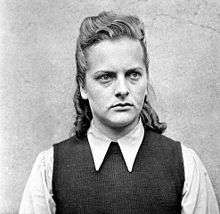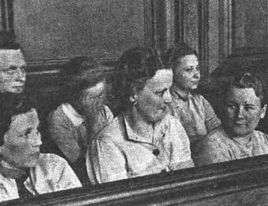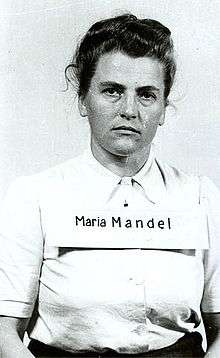Female guards in Nazi concentration camps
The Aufseherinnen were female guards in Nazi concentration camps during the Holocaust. Of the 55,000 guards who served in Nazi concentration camps, about 3,700 were women. In 1942, the first female guards arrived at Auschwitz and Majdanek from Ravensbrück. The year after, the Nazis began conscripting women because of a guard shortage. The German title for this position, Aufseherin (plural Aufseherinnen) means female overseer or attendant. Later female guards were dispersed to Bolzano (1944–45), Kaiserwald-Riga (1943-44), Mauthausen (March–May 1945), Neue Bremm (1943–44), Stutthof (1942–45), Vaivara (1943–44), Vught (1943–44), and at other Nazi concentration camps, subcamps, work camps, detention camps, etc.


Recruitment
Female guards were generally from the lower to middle class[1] and had no relevant work experience; their professional background varied: one source mentions former matrons, hairdressers, tramcar-conductresses, opera singers or retired teachers.[2] Volunteers were recruited by ads in German newspapers asking for women to show their love for the Reich and join the SS-Gefolge ("SS-Retinue", an SS support and service organisation for women). Additionally, some were conscripted based on data in their SS files. The League of German Girls acted as a vehicle of indoctrination for many of the women.[3] At one of the post-war hearings, Oberaufseherin Herta Haase-Breitmann-Schmidt, head female overseer, claimed that her female guards were not full-fledged SS women. Consequently, at some tribunals it was disputed whether SS-Helferinnen employed at the camps were official members of the SS, thus leading to conflicting court decisions. Many of them belonged to the Waffen-SS and to the SS-Helferinnen Corps.[4][5] Some female guards who served in the camps belonged to the Allgemeine-SS or the SS-Gefolge. Other women, such as Therese Brandl and Irmtraut Sell, belonged to the Totenkopf ("skull") units.[6]
At first, new recruits were trained at Lichtenburg concentration camp in Germany in 1938 and after 1939, at the Ravensbrück camp near Berlin. When World War II broke out, the Nazis built other camps in Poland, France, the Netherlands, Belgium and other countries they occupied. The female guards' training was similar to that of their male counterparts; the women attended classes which ranged from four weeks to half a year, headed by the head wardresses - however, near the end of the war little, if any, training was given to fresh recruits. Court records cite former SS member Herta Ehlert, who served at Ravensbruck, Majdanek, Lublin, Auschwitz and Bergen-Belsen, as describing her training as "physically and emotionally demanding" when questioned at the Belsen trial. According to her, the trainees were told about the corruption of the Weimar Republic, how to punish prisoners, and how to look out for sabotage and work slowdowns. The same sources have averred that Dorothea Binz, head training overseer at Ravensbruck after 1942, trained her female students in the finer points of "malicious pleasure" (Schadenfreude or sadism).[6]
Supervision levels and ranks
Female guards were collectively known as SS-Helferin (German: "Female SS Helper"). They were never given any positional titles or equivalent ranks of the SS. The supervisory levels within the SS-Helferin were as follows:
- Chef Oberaufseherin, "Chief Senior Overseer" [Ravensbrück]
- Lagerführerin, "Camp Leader"
- Oberaufseherin, "Senior Overseer"
- Erstaufseherin, "First Guard" [Senior Overseer in some satellite camps]
- Rapportführerin, "Report Leader"
- Arbeitsdienstführerin, "Work Recording Leader"
- Arbeitseinsatzführerin, "Work Input Overseers"
- Blockführerin, "Block Leader"
- Kommandoführerin, "Work Squad Leader" [Senior Overseer in some satellite camps]
- Hundeführerin, "Dog Guide Overseer"
- Aufseherin, "Overseer"
- Arrestführerin, "Arrested Overseer"
Luise Brunner and Anna Klein were both Chef Oberaufseherin. Female SS-Helferin were not recognized as regular members of the SS. For organizational purposes they were classed as auxiliaries who had no command powers over regular SS troops. Ravensbrück was the only Nazi camp reserved specifically for female inmates. It was run by SS officers using the SS-Helferin as guards and overseers.[6]
Daily life
Relations between SS men and female guards are said to have existed in many of the camps, and Heinrich Himmler had told the SS men to regard the female guards as equals and comrades. At the relatively small Helmbrechts subcamp near Hof, Germany, the camp commandant, Doerr, openly pursued a sexual relationship with the head female overseer Herta Haase-Breitmann-Schmidt.
Corruption was another aspect of the female guard culture. Ilse Koch, known as "the witch of Buchenwald", was married to the camp commandant, Karl Koch. Both were rumoured to have embezzled millions of Reichmarks, for which Karl Koch was convicted and executed by the Nazis a few weeks before Buchenwald was liberated by the U.S. Army; however, Ilse was cleared of the charge. She was sentenced to life imprisonment in 1951.
One apparent exception to the brutal female overseer prototype was Klara Kunig, a camp guard in 1944 who served at Ravensbruck and its subcamp at Dresden-Universelle. The head wardress at the camp pointed out that she was too polite and too kind towards the inmates, resulting in her subsequent dismissal from camp duty in January 1945. Her fate has been unknown since February 13, 1945, the date of the allied firebombing of Dresden.[7]
Camps, names and ranks

.jpg)
Near the end of the war, women were forced from factories in the German Labour Exchange and sent to training centres. Women were also trained on a smaller scale at the camps of Neuengamme; Auschwitz I, II, and III; Flossenbürg; Gross Rosen (as well as its satellites in Langenbielau, Ober Hohenelbe and Parschnitz); Vught and Stutthof, as well as a few at Mauthausen. Most of these women came from the regions around the camps. In 1944, the first female overseers were stationed at the satellite camps belonging to Neuengamme, Dachau, Mauthausen, a very few at Natzweiler Struthof, and none at the Mittelbau-Dora complex until March 1945.[8]
Thirty-four Aufseherinnen served in Vught, none at Buchenwald (except for two brothel Aufseherinnen (1942-November 1943) and possibly others during evacuations), sixty in Bergen Belsen, none at Dachau concentration camp (except for two brothel Aufseherinnen (1943) and possibly others during evacuations), twenty-three in Mauthausen (January 1945-May 1945), none at Dora Mittelbau proper, none at Natzweiler-Struthof proper, thirty at Majdanek, 200 at Auschwitz and its subcamps, 140 at Sachsenhausen and its subcamps, 158 trained at Neuengamme (over 400 in its satellites), forty-seven trained at Stutthof (150 in its entire complex of labor camps), compared to 958 who served in Ravensbrück (3,500 were trained there), 561 in the Flossenbürg complex, and over 800 in the Gross Rosen. Many female supervisors were trained and/or worked at subcamps in Germany, Poland, and a few in eastern France, a few in Austria, and a few in some camps in Czechoslovakia.[9]
- The head overseer at Allendorf was Oberaufseherin Kaethe Hoern (September 1944-March 1945); in Auschwitz Oberaufseherin Johanna Langefeld (March 1942-October 1942), Lagerfuehrerin Maria Mandel (October 1942-November 1944), Stellvertetende Oberaufseherin Emma Zimmer (1942–43), Stellvertretende Lagerfuehrerin Margot Dreschel (?-November 1944), Rapportfuehrerin Irma Grese (1944-of Hungarian Jewish women's compound under Mandl, Dreschel and Hasse), Arbeitsdienstfuehrerin Elisabeth Hasse, and Oberaufseherin Elisabeth Volkenrath (November 1944-January 1945). Mandl herself commanded all the 'SS' women within Auschwitz-Birkenau. Grese and Volkenrath were convicted of war crimes and hanged on 13 December 1945; Mandl was hanged on 24 January 1948.
- at Barth Lagerfuehrerin Gerda Langner (November 1943-1944), Lagerfuehrerin Irmgard Reissner (1944-April 1945), Stellvertretende Lagerfuehrerin Gertrud Herrmann, and Oberaufseherin Ruth Neudeck (March 1945-May 1945), in Belzig head female guard was Hedwig Ullrich (Summer 1944-April 1945).
- In Bergen Belsen the three head overseers were Oberaufseherin Elisabeth Volkenrath (February 1945-April 1945), Rapportfuehrerin Hildegard Gollasch, while Herta Ehlert served an additional deputy wardress and Irma Grese (January/February 1945-April 1945) was chief of prisoners labor as Arbeitsdienstfuehrrin. At the Gross-Rosen annex camp at Bernsdorf (Bernartice), Maria Muehl was Kommandofuehrerin under Lagerfuehrerin Else Hawlik, who commanded all of the 'Trautenau Ring' labor camps. At the Gross-Rosen annex camp at Breslau-Hundsfeld (Wroclaw Psie Pole) the Kommandofuehrerin was Emilie Kowa and another high female ranking officer-Margarete Schueller.
- Johanna Wisotzki was Oberaufseherin in Bromberg-Ost (Bydgoszcz East) from June 1944 until January/February 1945 along with Gerda Steinhoff, while Ilse Koch was appointed (unofficially) head female guard at Buchenwald, eventhough the camp had very few female prisoners. Koch was convicted of war crimes; she committed suicide in Aichach women's prison on 1 September 1967.
- At Christianstadt, a Gross-Rosen satellite in Silesia, Emilie Harms was in charge of the camp; her assistant was Stellvertretende Kommandofuehrerin Lina Pohl. In the Danzig Holm subcamp Stellvertreende Oberaufseherin Gerda Steinhoff was second-in-command of all the female overseers and prisoners (October 1944-December 1944); in the Dora Mittelbau satellite in Gross-Werther, this was handled by Lagerfuhrerin Erna Petermann.
- At the Ravensbrück/Flossenbürg subcamp at Dresden Universelle, Erstaufseherin Charlotte Hanakam and Erstaufseherin Ida Guhl were chief wardresses (1944-April 1945), and in Flossenbürg subcamp at Dresden-Goehle, this rank was given to several women, including Esratufseherin Margarethe de Hueber (1944); Erstaufseherin Gertrud Becker oversaw the Flossenburg satellite in Hainichen (October 1944-April 1945), Erstaufseherin Dora Lange and later Erstaufseherin Gertrud Weniger (1944-?) commanded Oederan.
- At the Gross Rosen sub-camp in Gabersdorf labour camp, Kommandofehrerin Charlotte Roessel was chief, and at the main camp Oberaufseherin Jane Bernigau was chief among all of the subcamps women guard personnel (800); in the Gruenberg (Zielona Góra) satellite, Lagerfuehrerin Anna Fiebeg (June 1944-January 1945) served as chief overseer, while Stellvetreende Lagerfuehrerinnen Anna Jahn and Hela Milefski Replacement Camp Overseers, Female.
- At Graeben, Kommandofuehrerin Katharina Reimann was head woman guard and Margarete Hentschel was her assistant as a Rapportfuehrerin; in Graeflish-Roehrsdorf, Silesia, Kommandofuehrerin Gertrud Sauer was in charge of the women's camp; and at the Gruschwitz-Neusalz subcamp of Gross Rosen Helene Obuch (1943-June 1944), then Kommandofuehrerin Elisabeth Gersch (June 1944-January 1945) was in charge, and at Hamburg-Wandsbek, Oberaufseherin Annemie von der Huelst was in charge, followed by her second-in-command, Kommandofuehrerin Loni Gutzeit. At Hamburg-Sasel, Kommandofuehrerin Ida Roemer was the head female guard.
- Helmbrechts was a subcamp of Flossenbürg built near Hof, Germany. Originally, Erstaufseherin Martha Dell' Antonia (Summer 1944-?) served there as head female guard over twenty-two female guards. In late 1944 she was replaced by the commandant's (Doerr's) mistress, Herta Haase-Breitmann, who was originally a Kommandofuehrerin.
- In Holleischen Dora Lange was senior overseer along with Anni Graf
- Kratzau I and II in Czechoslovakia were overseen by Kommandofuehrerin Elsa Hennrich and a certain Denner (or Dinner); Lenzing by Lagerführerin Schmidt and Oberaufseherin Margarete Freinberger (November 1944-May 1945).
- Majdanek was headed by Oberaufsherin Else Ehrich (October 1942-June 1944), her immediate assistant, Rapportfuehrerin and Stellvertretende Oberaufseherin Hermine Braunsteiner, and further deputies Else Weber, Redeli, Herta Ehlert (Ellert) and Elisabeth Knoblich. Knoblich was nicknamed "Halt die Klappe!" ("Shut up!") Hermine Braunsteiner was deported from the United States to Germany in 1973 and died in 1999.
- At the Mittelsteine concentration camp the head overseer was Kommandofuehrerin Philomena Locker (reportedly sentenced after the War to seven years' imprisonment), Charlotte Neugebauer, and a Fraulein Schneider (first name unknown). At Merzdorf Erna Rinke was Chief Overseer (Kommandofuehrerin).
- In Obernheide, Kommandofuehrerin Gertrud Heise was chief over seven (known) SS women (September 1944-April 1945), and in Plaszow, Oberaufseherin Elsa Ehrich, Anna Gerwing (as Rapportfuhrerin) and Kommandofuehrerin Alice Orlowski among another unknown woman.
- Ravensbrück was the training ground for female guards. Else Grabner was head of the female camp. Oberaufseherin (Chief Wardress), then Lagerleiterin (Camp Leader).[10] The chief wardresses there were Stellvertretende Oberaufseherin/Oberaufseherin Anne Zimmer (May 1939-May 1941), Oberaufseherin Maria Mandl (aka Maria Mandel; March 1942-October 1942), Stellvertrende Oberaufseherin Margarete Gallinat, Oberaufseherin Johanna Langefeld (May 1941-March 1942/October 1942 – 1943), Arbeitseinsatzfuehrerin Greta Boesel (1944-April 1945), while Dorothea Binz served as their assistant (Stellvertretende Oberaufseherin) from August 1943 until the camps liberation in April 1945. Binz and Boesel were convicted of war crimes and hanged on 2 May 1947. Ulla Jürß {1942-1944} and Ruth Neudeck {1944} were Blockführerin (Barrack Overseer, Female). Neudeck was later promoted to Oberaufseherin and moved to the Uckermark extermination complex down the road from Ravensbrück.
- Rochlitz was headed by Ertaufseherin Marianne Essmann.
- In St. Lambrecht it was Jane Bernigau (1942-1944), while at Stutthof there was Oberaufseherin Anna Scharbert promoted to chief female overseer after her time in Ravensbruck, Majdanek and Auschwitz, while at Theresienstadt this was given to Hildegard Neumann and Oberaufseherin Elisabeth Schmidt.
- Erstaufseherin Ruth Closius headed Uckermark (January 1945-March 1945); Oberaufseherin Margarete Gallinat (Maria) (1943-1944) and later Oberaufseherin Gertrud Weiniger (1944) oversaw Vught, Kommandofehrerin Susanne Hille was head female guard at Unterluess (or Vuterluss) (September 1944-April 1945). Oberaufseherin Anneliese Unger and a Fraulein Schneider oversaw the Flossenbürg subcamp at Zwodau from June 1944 until May 1945. Closius was convicted of war crimes and hanged on 29 July 1948.
- In researching his maternal German kin, American historian James L. Cabot found that two of his distant relations were overseers - Maria Kleinschmidt, an operative at Neuengamme, and Charlotte Kleinschmidt (née Peters), whose exact camp service is unknown.[11]
Prisoner Olga Lengyel, who in her memoir, Five Chimneys, wrote that selections in the women’s camp were made by SS Aufseherin Elisabeth Hasse and Irma Grese. In addition to those already mentioned as having been executed for war crimes, the following female guards were tried postwar, convicted of war crimes and executed: Sydonia Bayer of Litzmannstadt (Łódź), date unknown (in Poland); Juana Bormann of Bergen-Belsen, hanged 13 December 1945; Ruth Hildner of Helmbrechts, hanged 2 May 1947; Christel Jankowsky of Ravensbrück, date unknown (in East Germany); and Gertrud Schreiter and Emma Zimmer of Ravensbrück, both hanged 20 September 1948. An unknown number were summarily executed by the Soviets at the end of the war.[6]
From the post-war period until today
As the Allies liberated the camps, "SS" females were generally still in active service. Many were captured in or near the camps of Ravensbrück, Bergen Belsen, Gross Rosen, Flossenbürg, Salzwedel, Neustadt-Glewe, Neuengamme and Stutthof. After the war, many "SS" females were held at the internment camp at Recklinghausen, Germany or in the former concentration camp at Dachau. There, between 500 and 1,000 females were held while the U.S. Army investigated their crimes and camp service. The majority were released because SS males were the top priority. Many of the females held there were high-ranking leaders of the League of German Girls, while other females had served in concentration camps. Many SS males and females were executed by the Soviets when they liberated the camps, while others were sent to the gulags. Only a few "SS" females were tried for their crimes compared to SS males. Most female wardresses were tried at the Auschwitz Trial, in four of the seven Ravensbrück Trials, at the first Stutthof Trial, in the second and Third Majdanek Trials and from the small Hamburg-Sasel camp. At that trial all forty-eight SS males and females involved were tried.[6]
Female guards tried today
The last trial of a female overseer was held in 1996. Former Aufseherin Luise Danz, who served as overseer in January 1943 at Plaszow, then at Majdanek, Auschwitz-Birkenau and at the Ravensbrück subcamp at Malchow as Oberaufseherin, was tried at the first Auschwitz Trial and sentenced to life imprisonment in 1947. In 1956, she was released for good behavior. In 1996, she was once again tried for the murder of a young woman in Malchow at the end of the war. The doctor overseeing the trial told the court that the proceedings were too much for the elderly woman and all charges were dropped. As of 2011, Danz is still alive at the age of 94.[6]
In 1996, a story broke in Germany about Margot Pietzner (married name Kunz), a former Aufseherin from Ravensbruck, the Belzig subcamp and a subcamp at Wittenberg. She was originally sentenced to death by a Soviet court but it commuted to a life sentence and she was released in 1956. In the early 1990s, at the age of seventy-four, Pietzner was awarded the title "Stalinist victim" and given 64,350 Deutsche Marks (32,902 Euros). Many historians argued that she had lied and did not deserve the money. She had, in fact, served time in a German prison which was overseen by the Soviets, but she was imprisoned because she had served brutally in the ranks of three concentration camps. Pietzner currently lives in a small town in northern Germany. The only female guard to tell her story to the public has been Herta Bothe, who served as a guard at Ravensbrück in 1942, then at Stutthof, Bromberg-Ost subcamp, and finally in Bergen-Belsen. She received ten years' imprisonment, and was released in the mid-1950s. In a rare interview in 2004, Bothe was asked if she regretted being a guard in a concentration camp. Her response was, "What do you mean? ...I made a mistake, no... The mistake was that it was a concentration camp, but I had to go to it - otherwise I would have been put into it myself, that was my mistake."[12]
In 2006, 84-year-old San Francisco resident Elfriede Rinkel was deported by the US Justice Department. She had worked at Ravensbrück Concentration Camp from June 1944 to April 1945, and had used an SS-trained dog in the camp. She had hidden her secret for more than 60 years from her family, friends and Jewish German husband Fred. Rinkel immigrated to the US in 1959 seeking a better life and had omitted Ravensbrück from the list of residences supplied on her visa application. In Germany, Rinkel does not face criminal charges as only murder allegations can be tried after this amount of time,[13] although the case continues to be examined.[14]
Fictional portrayals
In the novel The Reader, a young man has an affair with an older woman (later revealed as a concentration camp guard) Hanna Schmitz. She is later tried in a court of law. In the film adaptation, she is portrayed by Kate Winslet.
In the film Seven Beauties, directed by Lina Wertmüller, the main character saves his life by having an affair with the female commander of a concentration camp, where he has been imprisoned for deserting the Italian Army.
Aufseherinnen are also portrayed in roles of varying size and importance in several other films:
• Female Nazis are commonly portrayed as dominatrixes.
- In Schindler's List, female guards can be seen in scenes involving the Plaszow labor camp and when the Schindler women arrive and depart from Auschwitz-Birkenau, as well as four at the Brunnlitz subcamp.
- Although unnamed, an overseer plays a prominent role in the 1975 film The Hiding Place, during scenes when Corrie and Betsie ten Boom are imprisoned at Ravensbruck. Several other female guards are seen processing new prisoners after their arrival at the camp.
- Maria Mandl (aka Maria Mandel) is portrayed by actress Shirley Knight in the film version of Playing for Time, centered on the Women's Orchestra of Auschwitz-Birkenau. Other Aufseherinnen are portrayed in smaller roles, processing prisoners and attending the orchestra's performances.
- Irma Grese has been portrayed as a minor character in Out of the Ashes as well as Pierrepoint (aka The Last Hangman in America), which details her execution following the Belsen war crimes trial. Both films feature additional female guards in much smaller roles. Grese is also briefly portrayed in a non-speaking re-enactment in Auschwitz: Inside the Nazi State.
- Polish actress Aleksandra Śląska played an Aufseherin in two films, first The Last Stage as the Oberaufseherin and later as Lisa in Pasazerka. Both films contain several minor Aufseherinnen characters.
- Female guards also appear in very small roles in the films Triumph of the Spirit, Battle of the V-1, and the beginning scene of X-Men.
- A character named "Ilsa" is a main protagonist in an exploitation movie Ilsa, She Wolf of the SS.
- In the 2014 video game Wolfenstein: The New Order, the fictional Camp Belica is run by a female SS officer named "Frau" Irene Engel.
Notes
- ↑ There were, however, some exceptions. At least four overseers were of aristocratic origin: Annemie von der Huelst and Gertrud von Lonski at Neuengamme and Euphemia von Wielen and Ellen Freifrau von Kettler at Ravensbrück. Brown, Daniel Patrick (2002), The Camp Women. The Female Auxiliaries Who Assisted the SS in Running the Nazi Concentration Camp System, pp. 226, 242. Atglen, Pa.: Schiffer Publishing Ltd.; ISBN 0-7643-1444-0
- ↑ Feig, Konnilyn G. (1981). Hitler's Death Camps: The Sanity of Madness. Holmes & Meier. ISBN 0-8419-0676-9.
- ↑ Aroneanu, Eugene (1996). Inside the Concentration Camps: Eyewitness Accounts of Life in Hitler's Death Camps. Greenwood Publishing Group. ISBN 0-275-95446-3.
- ↑ Rachel Century, Das SS-Helferinnenkorps Royal Holloway, University of London.
- ↑ Gerhard Rempel, The SS Female Assistance Corps (in) Hitler's Children: The Hitler Youth and the SS. UNC Press Books, 1989. ISBN 0807842990.
- 1 2 3 4 5 6 "Women of the SS", quotev.com; accessed 22 December 2014.
- ↑ Sarti, Wendy Adele Marie (2011). Women and Nazis: Perpetrators of Genocide and Other Crimes During Hitler's Regime, 1933-1945. Academica Press, p. 35
- ↑ Ausbeutung, Vernichtung, Öffentlichkeit: Neue Studien Zur Nationalsozialistischen Lagerpolitik, p. 38
- ↑ Daniel Patrick Brown, The Camp Women, The Female Auxiliaries who assisted the SS in Running the Concentration Camp System
- ↑ Female guards in Nazi concentration camps, fold3.com; accessed 22 December 22, 2014.
- ↑ Brown (2002), p. 140.
- ↑ Dreykluft, Friederike (2004). Holokaust (TV mini-series). Germany: MPR Film und Fernsehproduktion.
- ↑ Luke Harding, 'Shameful secret of the Nazi camp guard who married a Jew', The Guardian, 21 September 2006, Retrieved 22-04-2014
- ↑ Jeevan Vasagar, 'Six German women investigated over Auschwitz crimes,' The Telegraph, 9 August 2013 Retrieved 22-04-2014
References
- Aroneanu, Eugene, ed. Inside the Concentration Camps Trans. Thomas Whissen. New York: Praeger, 1996.
- Brown, Daniel Patrick, The Camp Women. The Female Auxiliaries Who Assisted the SS in Running the Nazi Concentration Camp System. Atglen, Pa.: Schiffer Publishing Ltd., 2002. ISBN 0-7643-1444-0
- Hart, Kitty. Return to Auschwitz: The Remarkable Story of a Girl Who Survived the Holocaust. New York: Atheneum, 1983.
- G. Álvarez, Mónica. "Guardianas Nazis. El lado femenino del mal" (Spanish). Madrid: Grupo Edaf, 2012. ISBN 978-84-414-3240-6
- Mailänder, Elissa & Patricia Szobar, eds. Female SS Guards and Workaday Violence: The Majdanek Concentration Camp, 1942-1944. East Lansing, MI: Michigan State University Press, 2015.
